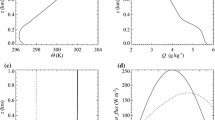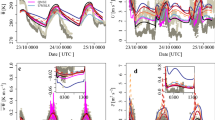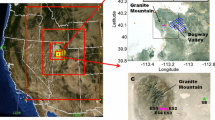Abstract
This paper compares a number of one-dimensional closure models for the planetary boundary layer (PBL) that are currently in use in large-scale atmospheric models. Using the results of a large-eddy simulation (LES) model as the standard of comparison, the PBL models are evaluated over a range of stratifications from free convective to neutral and a range of surface shear stresses. Capping inversion strengths for the convective cases range from weakly to strongly capped. Six prototypical PBL models are evaluated in this study, which focuses on the accuracy of the boundary-layer fluxes of momentum, heat, and two passive scalars. One scalar mimics humidity and the other is a top-down scalar entrained into the boundary layer from above. A set of measures based on the layer-averaged differences of these fluxes from the LES solutions is developed. In addition to the methodological framework and suite of LES solutions, the main result of the evaluation is the recognition that all of the examined PBL parameterizations have difficulty reproducing the entrainment at the top of the PBL, as given by the LES, in most parameter regimes. Some of the PBL models are relatively accurate in their entrainment flux in a subset of parameter regimes. The sensitivity of the PBL models to vertical resolution is explored, and substantive differences are observed in the performance of the PBL models, relative to LES, at low resolution typical of large scale atmospheric models.
Similar content being viewed by others
References
André, J. C., De Moore, G., Lacarrere, P., Therry, G., and Du Vachat, R.: 1978, ‘modelling the 24 h Evolution of the Mean and Turbulent Structures of the Planetary Boundary Layer’, J. Atmos. Sci. 35, 1861–1883.
Andrén, A., Brown, A., Graf, J., Mason, P., Moeng, C-H., Nieuwstadt, F. T. M., and Schumann, U.: 1994, ‘Large-Eddy Simulation of a Neutrally Stratified Boundary Layer: A Comparison of Four Computer Codes’, Quart. J. Roy. Meteorol. Soc. 120, 1457–1484.
Andrén, A. and Moeng, C-H.: 1993, ‘Single-Point Closures in a Neutrally Stratified Boundary Layer’, J. Atmos. Sci 50, 3366–3379.
Andrén, A.: 1990, ‘Evaluation of a Turbulence Closure Scheme Suitable for Air-Pollution Applications’, J. Appl. Meteorol. 29, 224–239.
Arya, S. P.: 1988, Introduction to Micrometeorology, Academic Press, 303 pp.
Augstein, H., Riehl, H. Ostopoff, F. and Wagner, V.: 1973, ‘Mass and Energy Transports in an Undisturbed Atlantic Trade Wind Flow’, Mon. Wea. Rev. 101, 101–111.
Ball, F. K.: 1960, ‘Control of Inversion Height by Surface Heating’, Quart. J. Roy. Meteorol. Soc. 86, 483–494.
Betts, A. K. and Miller, M. J.: 1986, ‘A New Convective Adjustment Scheme. Part II: Single Column Tests using GATE Wave, BOMEX, ATEX and Arctic Air-Mass Data Sets’, Quart. J. Roy. Meteorol. Soc. 112, 693–709.
Bradshaw, P.: 1972, ‘The Understanding and Prediction of Turbulent Flow’, Aero. J. 76, 403–418.
Briere, S.: 1981, ‘Energetics of Daytime Sea-Breeze Circulation as Determined from a Two-Dimensional, Third-Order Turbulence Closure Model’, J. Atmos. Sci. 44, 1455–1474.
Brost, R. A., Wyngaard, J. C., and Lenschow, D. H.: 1982, ‘Marine Stratocumulus Layers. Part II: Turbulence Budgets’, J. Atmos. Sci. 39, 818–836.
Brown, R. C. and Foster, R. A.: 1994, ‘On PBL Models for General Circulation Models’, Atmos. Ocean Syst. 2, 163–183.
Businger, J. A.: 1973, ‘Turbulent Transfer in the Atmospheric Surface Layer’, In D. A. Haugen (ed.), Workshop on Micrometeorology, Amer. Met. Soc, Boston, 392 pp.
Clarke, R. H., Dyer, A. J., Brook, R. R., Reid, D. G., and Troup, A. J.: 1971, ‘The Wangara Experiment: Boundary Layer Data’, Tech. Paper 19, Div. Meteorol. Phys. CSIRO, Australia.
Deardorff, J. W.: 1970, ‘A Numerical Study of Three-Dimensional Turbulent Channel Flow at Large Reynolds Numbers’, J. Fluid. Mech. 41, 453–480.
Deardorff, J. W.: 1972a, ‘Numerical Investigation of Neutral and Unstable Planetary Boundary Layers’, J. Atmos. Sci. 29, 91–115.
Deardorff, J. W.: 1972b, ‘Parameterization of the Planetary Boundary Layer for use in General Circulation Models’, Mon. Wea. Rev. 100, 93–106.
Deardorff, J. W.: 1972c, ‘Theoretical Expression for the Countergradient Vertical Heat Flux’, J. Geophys. Res. 77, 5900–5904.
Deardorff, J. W.: 1980, ‘Stratocumulus-Capped Mixed Layers Derived from a Three-Dimensional model’, Bound. Layer Meteorol. 18, 495–527.
Driedonks, A. G. M.: 1982, ‘Models and Observations of the Growth of the Atmospheric Boundary Layer’, Boundary-Layer Meteorol. 23, 283–306.
Dyer, A. J.: 1974, ‘A Review of Flux-Profile Relations’, Boundary-Layer Meteorol. 1, 363–372.
Galperin, B. and Orszag, S. A. Eds.: 1993, Large Eddy Simulation of Complex Engineering and Geophysical Flows, Cambridge U. Press, 600 pp.
Garratt, J. R.: 1993, ‘Sensitivity of Climate Simulations to Land-Surface and Atmospheric Boundary-Layer Treatment—A Review’, J. Climate 6, 419–449.
Grant, L. M.: 1986, ‘Observations of Boundary Layer Structure Made During the 1981 KONTUR Experiment’, Quart. J. Roy. Meteorol. Soc. 112, 825–841.
Helfand, H. M. and Labraga, J. C.: 1988, ‘Design of a Nonsingular Level 2.5 Second-Order Closure Model for the Prediction of Atmospheric Turbulence’, J. Atmos. Sci. 45, 113–132.
Herring, J. R. and Kerr, R. M.: 1982, ‘Comparison of Direct Numerical Simulations with Predictions of Two-Point Closures for Isotropic Turbulence Convecting a Passive Scalar’, J. Fluid Mech. 118, 205–219.
Holland, J. Z. and Rasmusson, E. M.: 1973, ‘Measurements of the Atmospheric Mass, Energy and Momentum Budgets over a 500 km Square of Tropical Ocean’, Mon. Wea. Rev. 101, 44–55.
Holtslag, A. A. M., De Bruijn, E. I. R., and Pan, H-L.: 1990, ‘A High Resolution Air Mass Transformation Model for Short-Range Weather Forecasting’, Mon. Wea. Rev. 118, 1561–1575.
Holtslag, A. A. M. and Moeng, C-H.: 1991, ‘Eddy Diffusivity and Countergradient Transport in the Convective Atmospheric Boundary Layer’, J. Atmos. Sci. 48, 1690–1698.
Holtslag, A. A. M. and Boville, B. A.: 1993, ‘Local Versus Nonlocal Boundary-Layer Diffusion in a Global Climate Model’, J. Climate 6, 1825–1842.
Kerr, R. M.: 1985, ‘Higher-Order Derivative Correlations and the Alignment of Small-Scale Structures in Isotropic Numerical Turbulence’, J. Fluid Mech. 153, 31–58.
Kim, J. and Mahrt, L.: 1992, ‘Simple Formulation of Turbulent Mixing in the Stable Free Atmosphere and Nocturnal Boundary Layer’, Tellus 44A, 381–394.
Klemp, J. B. and Durran, D. R.: 1983, ‘An Upper Boundary Condition Permitting Internal Gravity Wave Radiation in Numerical Mesoscale Models’, Mon. Wea. Rev. 111, 430–444.
Kline, S. J., Morkovin, M. V., Sovran, G., and Cockrell, D. J.: 1968, ‘Methods, Predictions Evaluation and Flow Structure, Volume 1’, Proc. Computation of Turbulent Boundary Layers- 1968 AFOSR-IFP-Stanford Conference.
Launder, B. E., Reece, G. T., and Rodi, W.: 1975, ‘The Development of a Reynolds Stress Turbulent Closure’, J. Fluid. Mech. 68, 537–566.
Louis, J-F: 1979, ‘A Parametric Model of Vertical Eddy Fluxes in the Atmosphere’, Boundary-Layer Meteorol. 11, 187–202.
Louis, J-F., Tiedtke, M., and Geleyn, J-: 1981, ‘A Short History of the PBL Parameterization at ECMWF’, Workshop on Planetary Boundary Layer Parameterization, 25–27 November, 1981, ECMWF.
Lumley, J. L.: 1978, ‘Computational modelling of Turbulent Flows’, Adv. Appl. Mech. 18, 123–176.
Mann, J., Davis, K. J., Lenschow, D. H., Oncley, S. P., Kiemle, C., Ehrt, G., Giez, A., and Schreiber, H. G.: 1995, ‘Airborne Observations of the Boundary Layer Top, and Associated Gravity Waves and Boundary Layer Structure’, Ninth Symposium on Meteorological Observations and Instrumentation, 27–31 March, 1995, American Meteorological Society, Boston, MA, pp. 113–116
McWilliams, J. C., Gallacher, P. C., Moeng, C-H. and Wyngaard, J. C.: 1993, ‘modelling the Oceanic Planetary Boundary Layer, In B. Galperin and S. A. Orszag, (eds.), Large Eddy Simulation of Complex Engineering and Geophysical Flows, Cambridge U. Press, 600 pp.
Mellor, G. L. and Yamada, T.: 1974, ‘A Hierarchy of Turbulence Closure Models for Planetary Boundary Layers’, J. Atmos. Sci. 31, 1791–1806.
Mellor, G. L. and Yamada, T.: 1982, ‘Development of a Turbulence Closure Model for Geophysical Fluid Problems’, Rev. Geophys. Space Phys. 20(4), 851–875.
Moeng, C-H. and Schumann, U.: 1991, ‘Composite Structure of Plumes in Stratus-Topped Boundary Layers’, J. Atmos. Sci. 48, 2280–2291.
Moeng, C-H. and Sullivan, P. P.: 1993, ‘A Comparison of Shear and Buoyancy Driven Planetary-Boundary Flows’, J. Atmos. Sci. 51, 999–1022.
Moeng, C-H. and Wyngaard, J. C.: 1988, ‘Spectral Analysis of Large-Eddy Simulations of the Convective Boundary Layer’, J. Atmos. Sci. 45, 3575–3587.
Moeng, C-H. and Wyngaard, J. C.: 1989, ‘Evaluation of Turbulent Transport and Dissipation Closures in Second-Order modelling’, J. Atmos. Sci. 46, 2311–2330.
Moeng, C-H.: 1984, ‘A Large-Eddy-Simulation Model for the Study of Planetary Boundary-Layer Turbulence’, J. Atmos. Sci. 41, 2052–2062.
Moeng,C-H. and Randall, D. A.: 1984, ‘Problems in Simulating the Stratocumulus-Topped Boundary Layer with a Third-Order Closure Model’, J. Atmos. Sci. 41, 1588–1600.
Nieuwstadt, F. T. M., Mason, P. J., Moeng, C-H., and Schumann, U.: 1993, ‘Large-Eddy Simulation of the Convective Boundary Layer: A Comparison of Four Computer Codes’, In Durst et al. (eds.), Turbulent Shear Flows 8, Springer-Verlag, Berlin, 431 pp.
Pollard, R. T., Rhines, P. B., and Thompson, R. O. R. Y.: 1973, ‘The Deepening of the Wind-Mixed Layer’, Geophys. Fluid Dyn. 4, 381–404.
Price, J. F. and Weller, R. A.: 1986, ‘Diurnal Cycling: Observations and Models of the Upper Ocean Response to Diurnal Heating, Cooling and Wind Mixing’, J. Geophys. Res. 91(C7), 8411–8427.
Price, J. F., Mooers, C. N. K., and Van Leer, J. C.: 1978, ‘Observation and Simulation of Storm-Induced Mixed Layer Deepening’, J. Phys. Oceanogr. 8, 582–599.
Randall, D. A., Shao, Q., and Moeng, C-H.: 1992, ‘A Second-Order Bulk Boundary-Layer Model’, J. Atmos. Sci. 49, 1903–1923.
Rogallo, R. S. and Moin, P.: 1984, ‘Numerical Simulation of Turbulent Flows’, Ann. Rev. Fluid Mech. 16, 99–137.
Schmidt, H. and Schumann, U.: 1989, ‘Coherent Structure of the Convective Boundary Layer Derived from Large-Eddy Simulations’, J. Fluid Mech. 200, 511–562.
Smagorinski, J.: 1963, ‘General circulation experiments with the primitive equations. I. The Basic Experiment’, Mon. Wea. Rev. 91, 99–164.
Stull, R. B.: 1993, ‘Review of Non-Local Mixing in Turbulent Atmospheres: Transilient Turbulence Theory’, Boundary-Layer Meteorol. 62, 21–96.
Stull, R. B.: 1988, An Introduction to Boundary Layer Meteorology, Kluwer Academic Publishers, Boston, 666 pp.
Stull, R. B.: 1984, ‘Transilient Turbulence Theory. Part 1. The Concept of Eddy Mixing Across Finite Distances’, J. Atmos. Sci. 41, 3351–3367.
Suarez, M. J., Arakawa, A., and Randal, D. A.: 1983, ‘The Parameterization of the Planetary Boundary Layer in the UCLA General Circulation Model: Formulation and Results’, Mon. Wea. Rev. 111, 2224–2243.
Sullivan, P. P., McWilliams, J. C., and Moeng, C-H.: 1994, ‘A Subgrid-Scale Model for Large-Eddy Simulation of Planetary Boundary-Layer Flows’, Boundary-Layer Meteorol. 71, 247–276.
Taylor, P. A. and Wyngaard, J. C.: 1990, PBL Model Evaluation Workshop: European Centre for Medium-Range Forecasts, 14–15 August 1989, Reading. World Climate Research Programme Series 42, WMO/TD 378.
Tennekes, H. and Driedonks, A. G. M.: 1981, ‘Basic Entrainment Equations for the Atmospheric Boundary Layer’, Boundary-Layer Meteorol. 20, 515–531.
Tennekes, H.: 1973, ‘A Model for the Dynamics of the Inversion above the Convective Boundary Layer’, J. Atmos. Sci. 30, 558–567.
Thompson, R. M., Payne, S. W., Reckel, E. E., and Reed, R. J.: 1979, ‘Structure and Properties of Synoptic Scale Wave Disturbances in the Intertropical Convergence Zone of the Eastern Atlantic’, J. Atmos. Sci. 36, 53–72.
Tjernström, M.: 1993, ‘Turbulence Length Scales in Stably Stratified Free Shear Flow Analyzed from Slant Aircraft Profiles’, J. App. Meteorol. 32, 948–963.
Troen, I. and Mahrt, L.: 1986, ‘A Simple Model of the Atmospheric Boundary Layer: Sensitivity to Surface Evaporation’, Boundary-Layer Meteorol. 37, 129–148.
Wyngaard, J. C. Ed.: 1984, Large-Eddy Simulation: Guidelines for its Application to Planetary Boundary Layer Research. US Army Research Office Contract No. 0804.
Yamada, T.: 1983, ‘Simulations of Nocturnal Drainage Flows by a q2l Turbulence Closure Model’, J. Atmos. Sci. 40, 91–106.
Yamada, T. and Mellor, G. L.: 1979, ‘A Numerical Simulation of BOMEX Data using a Turbulence Closure Model Coupled with Ensemble Cloud Relations’, Quart. J. Roy. Meteorol. Soc. 105, 915–944.
Zeman, O. and Lumley, J. L.: 1976, ‘modelling Buoyancy Driven Mixed Layers’, J. Atmos. Sci. 33, 1974–1988.
Zeman, O. and Tennekes, H.: 1977, ‘Parameterization of the Turbulent Kinetic Energy Budget at the Top of the Daytime Boundary Layer’, J. Atmos. Sci. 34, 111–123.
Zilitinkevich, S. S.: 1975, ‘Comments on a Paper by H. Tennekes’, J. Atmos. Sci. 32, 991–995.
Author information
Authors and Affiliations
Rights and permissions
About this article
Cite this article
Ayotte, K.W., Sullivan, P.P., Andrén, A. et al. An evaluation of neutral and convective planetary boundary-layer parameterizations relative to large eddy simulations. Boundary-Layer Meteorol 79, 131–175 (1996). https://doi.org/10.1007/BF00120078
Accepted:
Issue Date:
DOI: https://doi.org/10.1007/BF00120078




